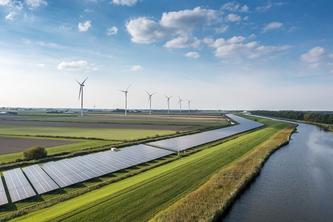
Water is essential to human well-being, yet reports of water shortages surface daily. Now, thanks to a team of global water experts, planning for water development and use just took a giant leap forward.
Researchers from the University of Minnesota Institute on the Environment, The Nature Conservancy, the Global Water Policy Project and the Center for Environmental Systems Research at the University of Kassel in Germany measured global water scarcity — the lack of sufficient water resources to meet demand — around the world at unprecedented resolution, incorporated seasonal and dry year shortages, and synthesized the information into a single, easily understandable global map that planners and policy-makers can use to improve access to water around the world. The result of their work was published today in the journal Elementa.
Most global water availability or scarcity maps look at big watersheds, sometimes as big as the whole Mississippi River basin, and average water use across the entire area. The new map examines watersheds at a smaller scale, offering a more detailed and accurate look at the water picture.
“By zooming in we are able to see more precisely where water is being used and whether more is being consumed than is renewed each year,“ said Kate Brauman, project lead and lead scientist of IonE’s Global Water Initiative.
“The good news is that in two-thirds of the world’s water basins, the renewable water supplies are being only lightly used,” said Brian Richter, study co-author and chief scientist at TNC’s Global Water Program. “The bad news is that water supplies are being very heavily exhausted in the other one-third. In those water-stressed basins, it is highly likely that freshwater ecosystems and species are in serious trouble from over-depletion of water flows.”
The map, created using the WaterGAP 3 global water resources model developed at the University of Kassel, examined water use and supply for more than 15,000 watersheds and sub-watersheds. The finer resolution and inclusion of seasonal and dry-year information allows researchers, planners and others to compare water scarcity in different areas.
“Cities, businesses, farmers and ecosystems all need a secure water supply to function. This tool identifies regions where steps may need to be taken to build resilience against the possibility of shortages during dry spells,” said Sandra Postel, study co-author and director of the Global Water Policy Project. “While no tool can serve as a crystal ball, this one helps remove some uncertainties by pinpointing at-risk areas.”
In addition to providing higher resolution and incorporating seasonal and dry-year information, the new map offers the additional benefit of summarizing global water data in a single place.
“This tool will make it so much easier to target water use, investment and conservation strategies. You don’t want to look at 12 maps of your watershed to see a seasonal trend, or try to compare those multiple watershed maps to maps from other parts of the world,” Brauman said. “We’re already using it to evaluate risk to different crops from water shortage, and to think about where to target conservation to improve river habitat. What I really hope is that people use these maps to explore and evaluate all kinds of questions that we haven’t even thought of yet.”
Marcus Malsy and Martina Flörke from the Center for Environmental Systems Research also contributed to the study.
The map is freely available to download at EarthStat.
The University of Minnesota’s Institute on the Environment seeks lasting solutions to Earth’s biggest challenges through research, partnerships and leadership development. For more information, visit environment.umn.edu.
- Categories:
- Agriculture and Environment





